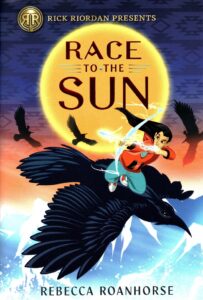Book review: Race to the Sun
Race to the Sun is an exciting fantasy novel inspired by Indigenous legends for young readers by Indigenous novelist Rebecca Roanhorse. The novel is part of the Rick Riordan Presents series for young readers that showcases authors from “underrepresented cultures and backgrounds” who are telling stories inspired by their cultures.
Roanhorse’s novel is drawn from Navajo stories about the Hero Twins while set in the contemporary Southwest, the lands of the Navajo or Diné. It presents the monsters, who traditionally are destroyers of the land and people, as those seeking to befoul the Earth through fracking. Race to the Sun follows Nizhoni Begay as she learns about her family’s direct descent from the Hero Twins and her own powers. Nizhoni’s powers give her the ability to detect and fight monsters threatening her family, the Navajo, and the Earth. These powers lead her to realize that a man named Charles who has offered her father a job in Oklahoma is a monster. After a failed attempt to kill Nizhoni, Charles kidnaps the father. Nizhoni, her brother Mac, and best friend Davery set out on their quest to save her kidnapped dad, the Diné, and their lands.
Many people from Diné stories make their appearance throughout the novel. The heroes, for example, meet Na’ashjéii Asdzáá (Spider Women), the four guardians of the sacred mountains, as well as Jóhonaa’éí (the Sun) who provide guidance, food, humour, lessons, and weapons. The trio also receives help from Diyin Dine’é (Diné Holy People). As they journey toward the home of the Sun, Nizhoni, Mac, and Davery experience various trials wherein they learn about themselves and each other while gaining the confidence to challenge the monsters threatening their family, friends, community, and the Earth.
Roanhorse’s work is aimed at showcasing a story where Navajo youth are the heroes of the story. She hopes that through her fantasy story, Indigenous readers will see themselves. Additionally, Roanhorse hopes that when the story is read by non-Indigenous children, a different light will be cast and stereotypes will be contested. While inspired by Navajo stories, Roanhorse is careful to note that Race to the Sun is not a cultural text. There are cultural elements within the story, but these are included as central to Indigenizing the characters, plot, and setting within the contemporary Southwest Navajo lands. Readers are encouraged by Roanhorse to seek Navajo Elders and story keepers to learn more. I would hope that the novel encourages all youth to learn more about Indigenous traditions and stories specific to the regions in which they live.
Regardless, as you read Race to the Sun, it is apparent that Roanhorse is excellent at her craft as the novel reads ‘true’ and ‘sincere’ rather than forced stereotypes or tropes of Indigenous people.
Race to the Sun, similar to Roanhorse’s Sixth World Series, focuses on monster slayers. The novel is set within the contemporary world and in some ways, serves as a prequel to the post-apocalyptic Sixth World Series. Regardless of the connections, Race to the Sun is an excellent stand-alone piece of fiction aimed at a youth audience but enjoyable for readers of all ages. It is an excellent fast-paced adventure where Indigenous youth are the heroes who save the day. It really is a must-read Indigenous fantasy novel, drawn from traditional stories, set within a modern world from the vantage point of a young woman. Simply, Race to the Sun is a fun read.
Rebecca Roanhorse. Race to the Sun. New York: Hyperion, 2020.
ISBN: 978-1368024662



